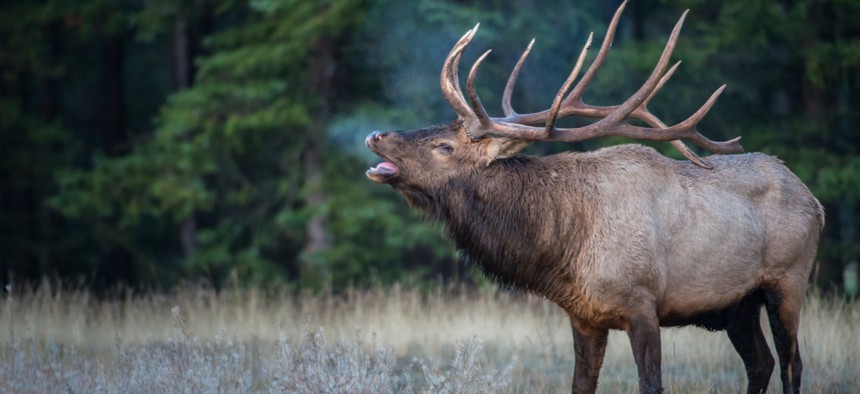Investigating Illegal Elk Poaching

Michigan's elk herd is carefully managed to stay between 800 and 1,200 animals. Shutterstock

Connecting state and local government leaders
Five elk were poached from mid-November to mid-December in Michigan, the most ever illegally killed in one month.
A week before Christmas, residents in northern Michigan called the state Department of Natural Resources to report a startling find: three female elk, shot dead in the snow.
The animals were killed outside of elk hunting season, their bodies left behind—the hallmarks of illegal poaching, the third such incident in Michigan in less than a month, said Lt. James Gorno, who works in the state DNR’s law enforcement division.
“These aren’t hunters,” he said. “These are poachers. They’re criminals.”
Michigan’s elk herd, located in the northeastern part of the state’s Lower Peninsula, is carefully managed to stay between 800 and 1,200 animals. The herd is one of the largest east of the Mississippi River and is a draw for tourists, who travel from neighboring states in hopes of catching a glimpse of the animals. Because of that, hunting season for elk is short, with around 100 participants issued permits each year via lottery.
“It’s taken many years to control and to have this elk herd up here without it being depleted,” Gorno said. “When someone comes up and takes some animals out of it, that affects the whole herd. We control the population with licensed hunting. It shouldn’t be controlled by poaching.”
Elk poaching is a criminal misdemeanor in Michigan, punishable with a fine of up to $500 or 90 days in jail. Violators can also be asked to pay restitution for the animal, Gorno said, which can cost as much as to $20,000, depending on its sex and stature (cow elk, or females, fetch less money than bull elk, or males).
Despite that, elk are poached every year. This season was shaping up to be relatively normal in that regard—two elk had been found killed in November—until the three cow elk were found shot as they prepared to bed down in the snow.
“That really kind of put it over the edge,” he said. “That was senseless—three cows just bedded and just shot and left to lay there. That should shock everybody.”
The elk were killed between Dec. 14 and 15, Gorno said. One was found in the bedding area, and another appeared to have tried to escape before collapsing. The third was found about 100 yards away. Footprints in the snow suggested that the poachers spotted the elk while driving.
“It’s such a waste of resource. It’s not an innocent thing. These were lying down. One died right in its bed,” he said. “The rest of the herd runs off, and who knows if there are others shot out of that group? It’s just a waste of resource and a waste of life.”
At least five elk were poached between mid-November and mid-December, according to the department. The first was a bull elk, weighing roughly 700 pounds, with antlers that had six points on one side and seven on the other. The department identified a suspect in that case within 48 hours, thanks to tips from the public, Gorno said.
The second, another bull elk, was found Nov. 19, weighing about 500 pounds, with antlers that had six points on one side and three on the other. It was killed by a single gunshot wound. No suspect has been identified. Investigations are ongoing, Gorno said, a painstaking process that begins by carefully combing the scene of the crime for clues.
“When we find the elk, we photograph it. It’s kind of like a crime scene,” he said. “If there’s snow or mud, we’ll photograph tire tracks. We’ll photograph and investigate footprints and boot prints that may have walked up to the animal. We’ll do a field autopsy, a necropsy on the animal, and find the bullet, which tells us what kind of weapon we’re looking for, even if we don’t have a suspect. There are lots of different physical signs we look for. And then we’ll ask a bunch of people if they’ve seen a suspicious vehicle or person.”
Tips from the public are key, Gorno said, and the department will continue to investigate cases for years in the absence of new leads.
“We’re about 50% or higher on solving elk cases,” he said. “Sometimes it takes years. We have elk cases we’re still working on from five years ago. We’ve solved cases based on the fact that boot prints match the prints from another case three years ago. So it’s too early to say we’re giving up on any of these, and we won’t give up.”
Virtually all known elk poaching cases begin with the animal’s carcass being left behind, which Gorno said is likely due to a lack of knowledge about the size of the species.
“It’s a big animal, anywhere from 400 to 800 pounds,” he said. “You’re going to need a couple of people, at least, to get that into a pickup. A lot of times, we think they shoot it and then they get scared off.”
Reasons for poaching vary. Occasionally, it’s a mistake, Gorno said—people accidentally shoot an elk while hunting other animals and turn themselves in. In those cases, the state will usually work with the courts to lessen the charges. But more often, it’s killing for the sake of killing, he said.
“It’s, ‘Hey, look at that, I’m going to shoot it and try to take it,’” he said. “And then they just run off and leave it. Lots of times it can be a mistake, but more often than not, it’s malicious poaching and just a waste of resources.”
Kate Elizabeth Queram is a Staff Correspondent for Route Fifty and is based in Washington, D.C.

NEXT STORY: Equal Rights Amendment Clears First Step in Virginia, as Trump Administration Declares Effort Dead




